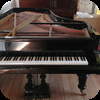hi guyz, right now I'm using a behringer b2pro. very entry level microphone. I wanted to ask you if you had a microphone (not in pairs) to recommend for recording a grand piano at home.
the room is (4x10) and the piano is a beautiful bluthner 220 cm from 1890.
i was looking for RODE nt1 / Okm II or a Akg P420. unlikely i cant go over 200 $.
i would want to start with only one microphone for now. any ideas ?
Comments
I agree with Paulears, there is so many variables which is what
I agree with Paulears, there is so many variables which is what recording is all about.. Gear choice is just one of the thing that can complement or ruin a recording..
I know the gear selling industry make us believe you can sound like a pro for 100$ but we shouldn't believe everything they say.. They want to sell, more and more that's all. . .
Recording an acoustic piano with 200$ budget is a pretty ambicious project.
If the purpose is to keep ideas you compose or learning to record, anything you do will be fine as long as you just do it..
For an album ? not sure. I'd put my money in a good midi controler and use a VSTi (virtual instrument) instead. Save time, money and produce the album faster.
OR you put the money to go to a pro studio.. many are 30-50$ an hour..
It all depends on the goals you have. ;)
sry, I didn't explain myself well. its onyl for me,like an hobb
sry, I didn't explain myself well. its onyl for me,like an hobby but not for thaht will be bad. i was looking for a rode nd 5 (300 $).
somewhere I have to start. in the meantime microphones are chosen in the basic budget. I don't think there can't be an intermediate band
I think that for the piano - you'd really be better with a pair
I think that for the piano - you'd really be better with a pair of mics, because that's more natural, more spacious and realistic. one mic means mono - and nowadays we don't do mono really.
How about a pair of AKG P120's? They're modestly priced, and while a little bright, could complement you piano, and give you the option to eq the low end against the high end, and find the piano's sweet spots for microphones.
I assume you have the interface? Mics are like buying paint for your walls - you choose, and either love it and keep it on the walls for years, or you really don't like it, and repaint next year.
Paul and Marco (pcrecord) have made very good suggestions. There
Paul and Marco (pcrecord) have made very good suggestions. There are two further points that are worth making:
1) When recording a grand piano, particularly one of the quality you have access to, you should consider using omni-directional microphones in order to do justice to the lower octaves. The response of cardioid patterns does not usually go low enough, simply because of the way they are constructed. So a microphone that has interchangeable omni capsules such as the Rode NT55 or else a switchable-pattern microphone that has a omni setting is to be preferred.
2) Very many of the lower-cost large-diaphragm condenser microphones are "voiced" to have a frequency-response lift of several dB in the 2 - 8 KHz range. The manufacturers' justification for this is that it helps vocal tracks recorded with the microphone to cut through instrumental accompaniment backing. That may be true in some cases, but it goes against getting a good sound when trying to use the microphone to record a solo grand piano. What you get is a rather shrill sound that is tiring to the ear. It can be compensated for to some extent by using EQ controls in the mix, but you still don't get a result that is as pleasant to listen to as a microphone that is not voiced in that way.
Of the microphones you mention, the AKG P420 switched to omni pattern probably meets these two requirements the best. I've never used a P420 on a piano, but it made a reasonable job of a clarinet the last time I had one to try.
Please tell us the model of the interface you are using. Finally, as Paul has said, really try to get two microphones and record in stereo.
Some moving blankets could be helpful to dampen the room a bit.
Some moving blankets could be helpful to dampen the room a bit. The physical location of the mics and piano can make a significant difference.
Also, tuning is important, especially if using vsti's in the rest of the song.
One thing to keep in mind about the nt5 is there is no pad, so it is possible to overload the mic easier than many others. Not a dealbreaker per se, but something to consider.
The p420 would likely be more versatile, for vocals ect. LDCs generally have a more extended low frequency response relative to SDC's.
I like the nt5s alot (and generally don't like the other rode mics ive used nt1a, nt2, k5) but i wouldn't pick the nt5 as my first mic or only mic.






You're really just going to have to risk it. The mic will either
You're really just going to have to risk it. The mic will either comliment your piano, or fight with it. The piano, the mic, the room and placement are all variables to a degree. You can move the piano, you can treat the room, you can move the mic, and experiment with the lid. You then get to apply eq and processing if you want. The Rode seems a sensible pick for me, as I know what it sounds like.